Ah, the wonderfully cryptic world of tire codes. You’ve probably noticed these seemingly enigmatic numbers and letters on your car’s tire and thought, “Are these hieroglyphs or secret codes meant for James Bond?” Well, grab your detective glasses and fasten your seatbelt, because we’re about to embark on a thrilling decoding journey.
What do 82t, 82s, 82q, 82h, 82r, 82v, and 82w mean on a tire?
These alphanumeric strings, dear reader, refer to the load index and speed rating of your tire. The number ’82’ is the load index, indicating the maximum load the tire can safely support. The letters, from ‘t’ to ‘w,’ are speed ratings, signifying the maximum speed for which the tire is certified. Here’s a brief overview:
| Load Index and Speed Symbol | Speed Rating | Maximum Speed (mph) | Maximum Speed (km/h) |
| 82Q | Q | 99 mph | 160 km/h |
| 82S | S | 112 mph | 180 km/h |
| 82T | T | 118 mph | 190 km/h |
| 82H | H | 130 mph | 210 km/h |
| 82V | V | 149 mph | 240 km/h |
| 82W | W | 168 mph | 270 km/h |
| 82Y | Y | 186 mph | 300 km/h |
Let’s dive deeper into the meaning of ’82T’ and ’82S.’
What does 82T mean on a tire?
’82T’ on a tire is like an identification badge showing two critical details about the tire’s capability. The ’82’ tells us that this tire can support a maximum weight of 475kg or 1047lbs. ‘T,’ the speed rating, suggests this tire is cleared for speeds up to 118mph or 190km/h. Not quite Formula 1, but fast enough to get your heart racing!
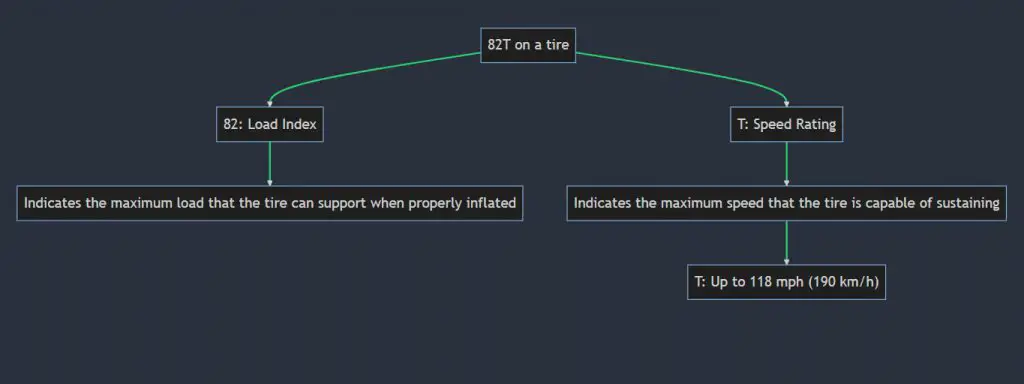
Specifics about 82T Tires
82T tires are versatile, the jack-of-all-trades in the tire world. Let’s see what makes them so popular.
Typical Use Cases for 82T Tires
These tires are designed for everyday use, making them perfect for commuting, errands, or even long-distance highway driving. They balance durability and performance quite well.
Vehicles Suitable for 82T Tires
82T tires are commonly found on compact cars, sedans, and some smaller SUVs. Here are some examples:
- Honda Civic
- Toyota Corolla
- Subaru Forester
Precautions when Using 82T Tires
Ensure you do not exceed the tire’s speed and load capacity. And remember, tires are like people – they age, and their performance declines over time. Regular tire maintenance is a must!
FAQ’s
Q: Can I replace 82T tires with a different rating?
A: Yes, but ensure the new tires have an equal or higher speed and load rating.
Q: Are 82T tires suitable for all weather conditions?
A: These tires are typically all-season, but always check the manufacturer’s specifications.
What does 82S mean on a tire?
When you see ’82S’ on a tire, it indicates the tire’s load capacity is 475kg (1047lbs), similar to the 82T. However, the ‘S’ speed rating means the tire is certified for speeds up to 112mph or 180km/h. It’s like the 82T’s slightly more conservative sibling, always obeying the speed limit.
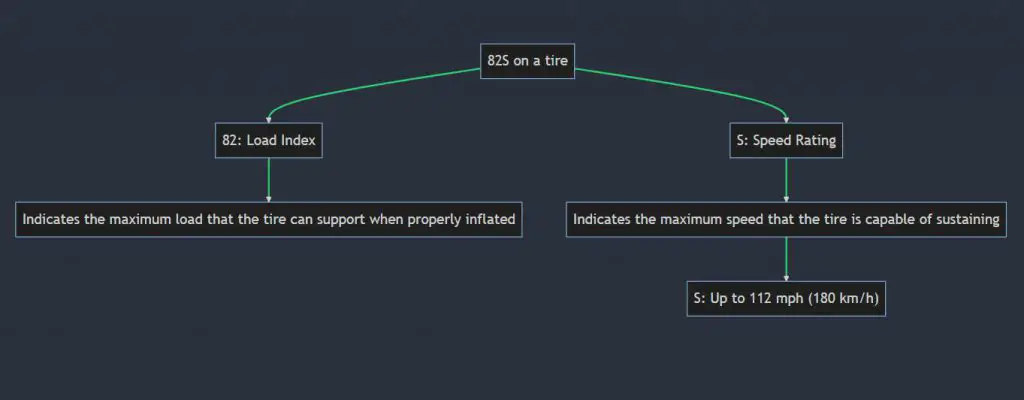
Specifics about 82S Tires
The 82S tire is like the diligent student who always follows the rules – not the fastest, but reliable.
Typical Use Cases for 82S Tires
Ideal for city driving and occasional highway trips, these tires are designed for lower speeds but offer excellent stability and comfort.
Vehicles Suitable for 82S Tires
82S tires are often found on compact cars and small to mid-size sedans. Here are some examples:
- Ford Focus
- Hyundai Elantra
- Honda Accord
Precautions when Using 82S Tires
Never exceed the tire’s speed and load capacity, and regularly check tire pressure and tread depth. Tires are not just rubber doughnuts; they are your car’s shoes!
FAQ’s
Q: Can 82S tires handle winter conditions?
A: While 82S tires are typically all-season, for harsh winter conditions, consider winter or snow tires.
Q: Can I mix 82S tires with other speed ratings?
A: No, it’s recommended to keep the same speed rating for all tires to ensure balanced performance.
What does 82q mean on a tire?
If you find ’82q’ on your tire, congratulations! You’ve discovered your tire’s “hidden identity”. The number ’82’ is the load index, stating the tire can safely carry up to 475 kg (1047 lbs).
The ‘q’, the speed rating, shows this tire isn’t built for speed, but it’s steady and reliable, certified for a maximum speed of 99 mph or 160 km/h. Imagine this tire as a marathon runner. Not sprinting, but with the endurance to keep a steady pace for the long haul.
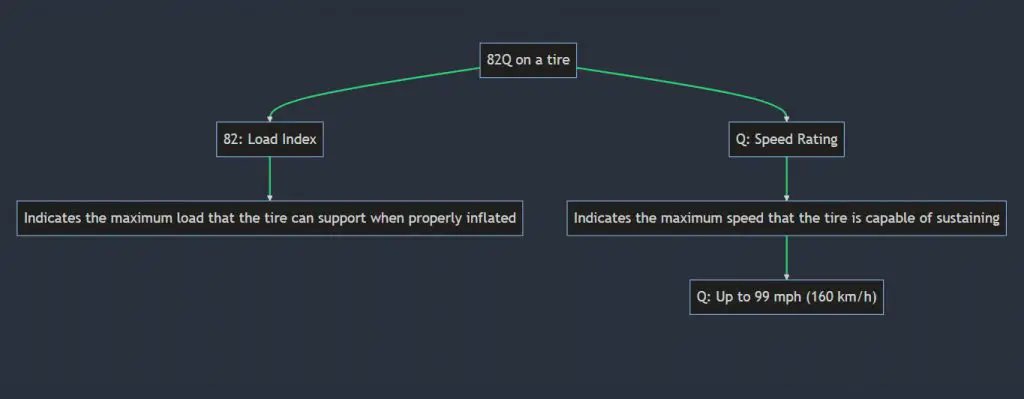
Specifics about 82q Tires
82q tires aren’t the flashy race car tires; they are more like a dependable workhorse. Let’s delve deeper.
Typical Use Cases for 82q Tires
These tires are designed for slower-paced, safe driving—ideal for city roads and light off-road driving. They are the tortoise in the “Tortoise and the Hare” fable – they won’t rush, but they’ll get you there.
Vehicles Suitable for 82q Tires
82q tires fit comfortably on small to mid-sized cars, light trucks, and minivans. Vehicles like:
- Ford Transit Connect
- Volkswagen Golf
- Subaru Crosstrek
Precautions when Using 82q Tires
Don’t exceed the specified speed limit and load capacity. Remember, your tire is like your trusted steed – treat it with care!
FAQ’s
Q: Can I use 82q tires for highway driving?
A: Yes, but they are more suited to slower speeds, so stay in the right lane and enjoy the scenery.
Q: Are 82q tires suitable for winter conditions?
A: While they can handle light snow, for severe winter weather, it’s best to use winter or snow tires.
What does 82h mean on a tire?
Finding ’82h’ on your tire? That’s the tire’s way of saying, “I can carry up to 475 kg (1047 lbs), and oh, I can dash up to 130 mph (210 km/h).” ’82’ is the load index, and ‘h’ is the speed rating. If ’82q’ was the marathon runner, then ’82h’ is more like Usain Bolt, but in the world of tires.
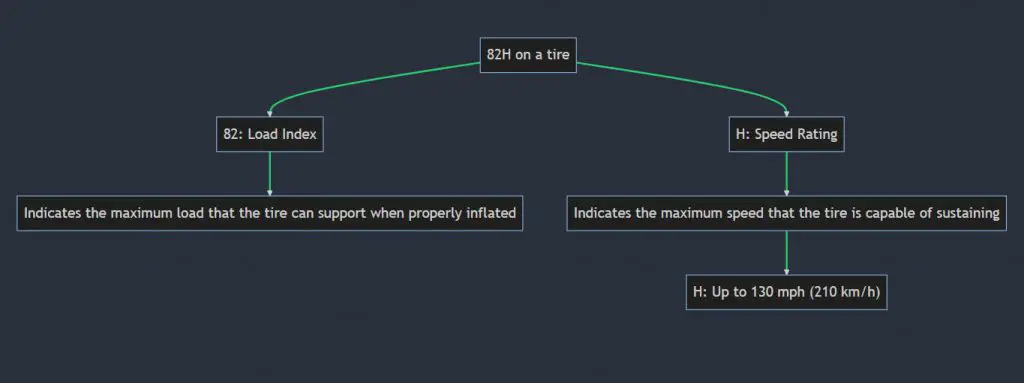
Specifics about 82h Tires
82h tires are the balanced individuals of the tire world, combining reliability with a decent speed range.
Typical Use Cases for 82h Tires
82h tires are great all-rounders, suitable for city and highway driving, even light off-road use. They might not win the Indy 500, but they’ll never let you down on your daily commute.
Vehicles Suitable for 82h Tires
82h tires can be found on a range of vehicles including compact cars, small SUVs, and some crossovers. Vehicles like:
- Honda CR-V
- Toyota RAV4
- Hyundai Tucson
Precautions when Using 82h Tires
Don’t exceed the tire’s maximum speed and load limit. And don’t forget to check tire pressure regularly. After all, a happy tire makes a happy drive!
FAQ’s
Q: Can 82h tires be used in winter conditions?
A: 82h tires are generally all-season. However, in severe winter conditions, dedicated winter tires are recommended.
Q: Can I mix 82h tires with other speed ratings?
A: Not recommended. Keeping the same speed rating ensures balanced performance.
What does 82r mean on a tire?
Ever wondered what ’82r’ signifies on your tire? It’s your tire’s secret code. The ’82’ is the load index indicating that your tire can safely carry up to 475 kg (1047 lbs), and ‘r’ is the speed rating that symbolizes a maximum speed of 106 mph (170 km/h). Think of it as the tortoise from Aesop’s fables, steady, reliable, and never rushing, ensuring your safe arrival at your destination.
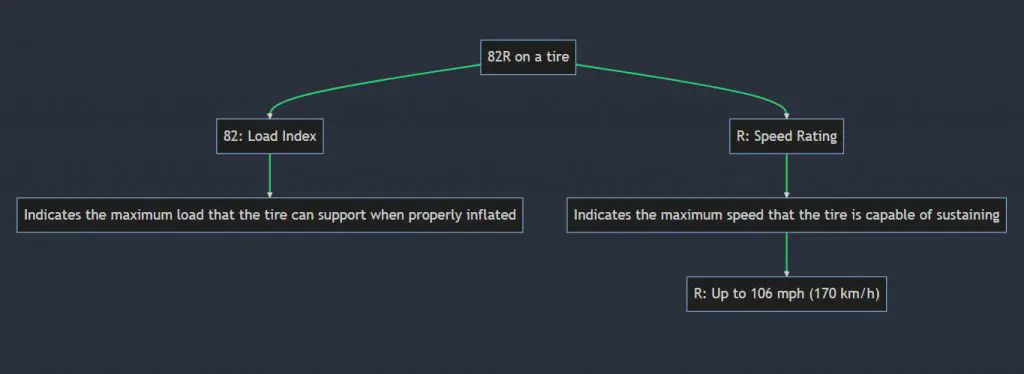
Specifics about 82r Tires
82r tires may not be the racers of the tire world, but their steady pace and resilience make them a reliable choice.
Typical Use Cases for 82r Tires
82r tires are perfect for city driving, daily commutes, and the occasional off-road adventure where you don’t need to rush.
Vehicles Suitable for 82r Tires
These tires are often found on small to mid-size sedans and SUVs. You’ll find them on:
- Ford Focus
- Subaru Forester
- Nissan Rogue
Precautions when Using 82r Tires
Remember, tires are like a good pair of shoes; you don’t want to overuse them. Never exceed their speed and load limit, and remember to do regular checks.
FAQ’s
Q: Are 82r tires good for long road trips?
A: Yes, as long as you keep to the speed limit and take regular breaks.
Q: Can I use 82r tires in winter conditions?
A: While they can handle light snow, for severe winter conditions, consider winter tires.
What does 82v mean on a tire?
On spotting ’82v’ on your tire, you’re seeing its ID card. ’82’ is the load index, meaning your tire can carry up to 475 kg (1047 lbs). ‘v’, the speed rating, indicates a maximum speed of 149 mph (240 km/h). These tires are like sprinters, ready for quick acceleration, but also maintaining a steady pace for the long haul.
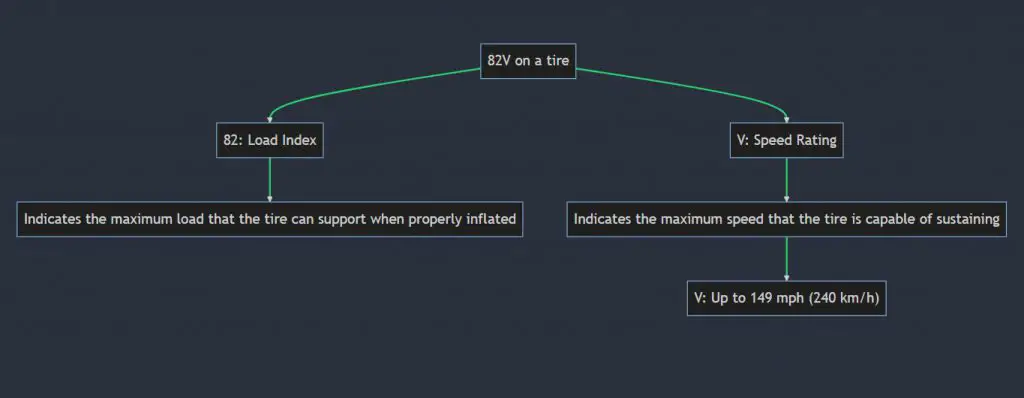
Specifics about 82v Tires
82v tires bring a blend of speed and stability, offering a comfortable ride at high speeds.
Typical Use Cases for 82v Tires
Perfect for highway driving and spirited city driving, these tires are designed for those who appreciate a bit more pace in their drive.
Vehicles Suitable for 82v Tires
82v tires are found on sport sedans and some sporty SUVs. You may find them on:
- BMW 3 Series
- Audi A4
- Mercedes-Benz C-Class
Precautions when Using 82v Tires
As with any tire, avoid exceeding their speed and load limit. And remember, speed is thrilling, but safety comes first!
FAQ’s
Q: Are 82v tires suitable for track use?
A: While they can handle higher speeds, for track use, consider performance tires.
Q: Are 82v tires noisy at high speeds?
A: Tire noise depends more on tire design and road conditions than speed ratings.
What does 82w mean on a tire?
Finding ’82w’ on your tire reveals its capabilities. The ’82’ is the load index, meaning your tire can handle up to 475 kg (1047 lbs), and ‘w’ as the speed rating denotes a high-speed capability of up to 168 mph (270 km/h). It’s like your tire is whispering, “I’m ready for some serious speed.”
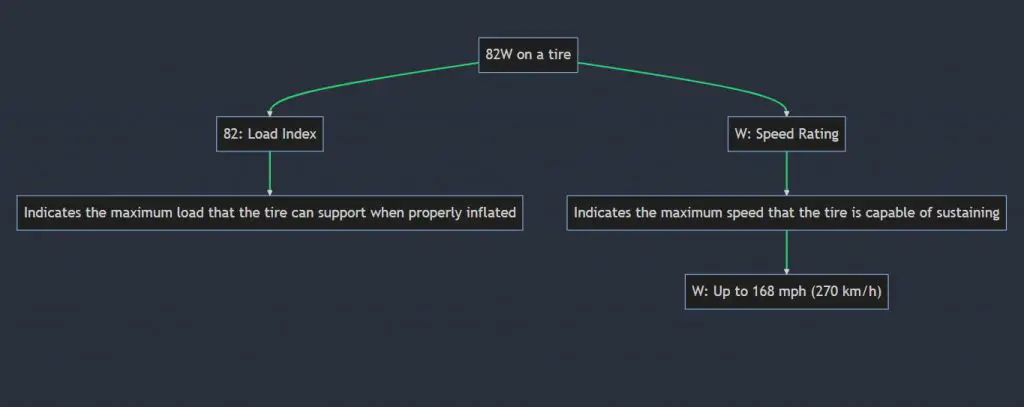
Specifics about 82w Tires
82w tires are the speedsters of the tire world, but they still respect the rules of safety.
Typical Use Cases for 82w Tires
These tires are designed for those who enjoy the thrill of speed. They’re perfect for highway drives and for those who enjoy a spirited drive on curvy roads.
Vehicles Suitable for 82w Tires
You’ll often find 82w tires on sporty sedans and performance-oriented SUVs, such as:
- BMW M3
- Audi S4
- Mercedes-Benz AMG GLC 43
Precautions when Using 82w Tires
While these tires are built for speed, remember the importance of safety. Always stick to speed limits and ensure your tires are in good condition.
FAQ’s
Q: Can I use 82w tires on a non-performance car?
A: Yes, but it’s like putting a racehorse in a pony ride. You won’t fully utilize its capabilities.
Q: Are 82w tires more prone to wear and tear?
A: Not necessarily. However, aggressive driving styles can lead to faster wear.
Recap And Summary
After an exhilarating journey through the world of tire markings, it’s time to pull into the recap pit stop. By now, you’ve gained knowledge of the load index and speed ratings of various tires, ranging from the steady 82r to the swift 82w. But the question that might be burning brighter than the rubber on a race track is: why does it matter?
Why is it important to know the load index and speed rating of a tire?
Knowledge of the load index and speed rating of your tire is crucial because, just like you wouldn’t wear flip-flops to climb a mountain, you don’t want your car wearing the wrong “shoes” for the journey you plan to take.
The load index and speed rating of a tire together constitute the tire’s identity. They tell you what your tire is capable of and, most importantly, what it’s not.
They help you understand your tire better, ensuring that you can use it to its maximum potential, all while prioritizing your safety.
Imagine planning a camping trip and loading up your vehicle with all the essentials – tents, food, camping gear, and maybe even a canoe.
If your tires have a lower load index than needed, you could be setting up yourself for a disastrous trip. Overloading tires can lead to excessive heat build-up, which could result in tire failure, leaving you stranded in the middle of nowhere with a marshmallow skewer as your only tool. Not exactly the camping trip you envisioned!
Similarly, the speed rating on your tire is not there to just inspire your inner speed demon. It’s a safety parameter set by the tire manufacturer.
Using a tire beyond its speed rating can result in tire failure, and remember, no one wants a pit-stop at the hospital.
Consider a scenario where you’re on a German autobahn with no speed limit, or you’ve just dropped the kids off at school and the highway is clear – tempting, right?
But, just before you decide to test the upper limits of your speedometer, your tires have a gentle reminder for you, the speed rating. The ‘w’ or the ‘h’ is there to tell you exactly how fast you can go without risking safety.
In short, knowing the load index and speed rating is about ensuring safety while extracting the best performance from your tires. It’s about understanding that every tire has its unique capabilities and limitations, and respecting them is key to safe and effective tire usage.
After all, tires are more than just round, rubbery parts of your car – they’re the very things that stand between you and the road, ensuring you stay grounded while you chase the horizon.
So, take a moment, kneel down, and take a closer look at your tires – because sometimes, the secrets to a safe and smooth drive are literally written on the rubber!
FAQs
Q: What’s the difference between 82v and 82h tires?
A: The key difference lies in their speed ratings. While both have the same load index of ’82’, meaning they can carry up to 475 kg (1047 lbs), the speed rating is different. The ‘h’ rating denotes a maximum speed of 130 mph (210 km/h), while ‘v’ represents a maximum speed of 149 mph (240 km/h). So, the 82v tire is built for higher speeds than the 82h tire.
Q: How do 82t and 82h tires compare?
A: Again, the load index is the same for both, but the speed ratings differ. 82t tires have a maximum speed rating of 118 mph (190 km/h), while 82h tires can go up to 130 mph (210 km/h). Therefore, if you’re someone who drives at higher speeds, the 82h tire would be a better fit for your vehicle.
Q: What’s the difference between 82t and 82s tires?
A: The difference between these two tires lies in their speed ratings. While both can carry a load of up to 475 kg (1047 lbs), the 82s tire is rated for a maximum speed of 112 mph (180 km/h), while the 82t tire can handle speeds up to 118 mph (190 km/h). Thus, 82t tires can withstand slightly higher speeds than 82s tires.
Q: How different are 82t and 82h tires?
A: 82t and 82h tires both have the same load capacity, but different speed ratings. The 82h tires can go up to a maximum speed of 130 mph (210 km/h), while the 82t tires are rated for speeds up to 118 mph (190 km/h). So, if you drive at higher speeds, 82h tires would be the better option.
Final Verdict
Understanding the load index and speed rating of your tires is crucial in ensuring the safety and performance of your vehicle. Each tire rating is suited to different driving styles and conditions, so it’s essential to match your tires to your driving habits and vehicle needs.
Whether you’re a city cruiser, a highway speedster, or somewhere in between, there’s a tire out there that speaks your language. Remember, knowledge is power, and in this case, it’s the power to choose the right tires, drive safer, and get the best out of your vehicle. Happy driving, folks!
Alternative Tire Size Codes of Similar Specifications

AR Jeet has been a tire mechanic for over 2years. He has worked on all types of vehicles, from cars and trucks to RVs and ATVs and motorcycles. He has seen it all when it comes to tires, and he knows how to fix them.
AR Jeet is a tire expert, and he is passionate about his work. He loves to help people keep their vehicles running smoothly, and he is always happy to answer any questions that people have about their tires.
If you need help with your tires, or if you just want to learn more about them, then AR Jeet is the man to talk to. He will be happy to help you out, and he will make sure that you get the best possible solution.
He has a blog [Tirespick.com] where he writes about all things tire-related, and he is always happy to help people with their tire needs. Know more about AR Jeet.
